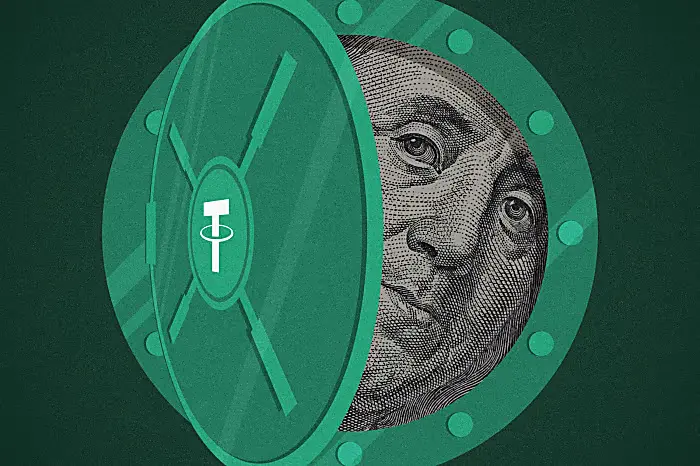Foresight Ventures: "Separation After Long Union" Modular Blockchain and Data Availability Layer
Author: msfew, Foresight Ventures
The Bottleneck of Rollup
If you read my previous article on Rollup, you might have noticed that there was intentionally or unintentionally a gap left in the comparison section between Optimistic and zk Rollup.
The conclusion drawn at that time was: due to the lack of Proving Overhead, Optimistic Rollup will far surpass zk Rollup in the long run. However, in terms of performance development over different time periods, Optimistic and zk Rollup will actually alternate in leading:
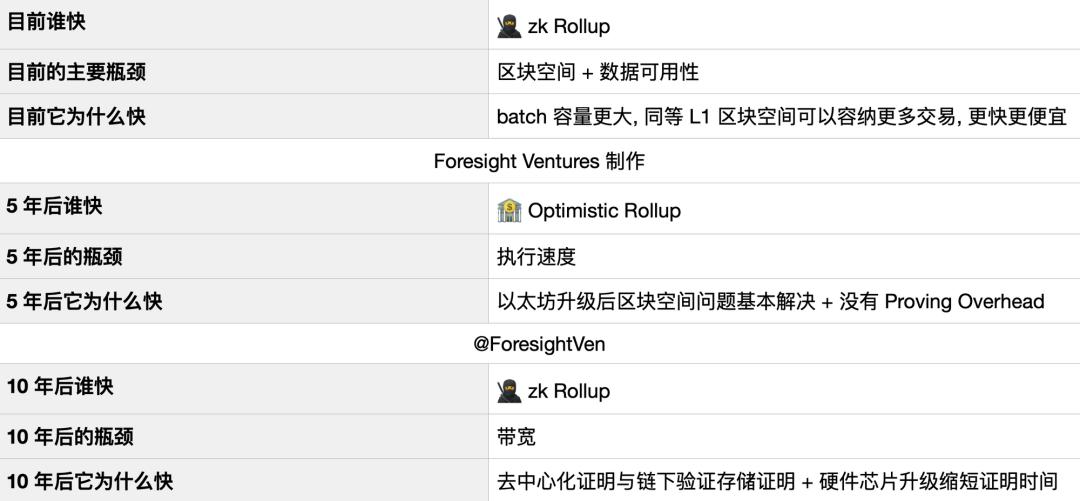
Different types of Secured Rollup have different bottlenecks at different stages, and currently, for them, the main issue is still that the data availability solutions provided by Ethereum limit their peak theoretical performance.
To address the performance issues of Rollup at this stage, we have two methods:
- Upgrade Ethereum's mainnet, waiting for a successful upgrade; the downside is that we cannot take the initiative, and this may take a long time.
- Switch the type of Rollup (e.g., change to Validium), directly using a more efficient data availability solution; the downside is that it sacrifices some security.
Modularization of Blockchain
The Secured Rollup we refer to (like Arbitrum, etc.) is actually an implementation of modular blockchain, and in the future, there will be more different implementations of modular blockchain, or different variants of Rollup.
Ethereum's Rollup roadmap reflects the modularization trend of blockchain, allowing for the separation of layers in blockchain, each performing its own role, enabling the network to roll up.
The previous article on Rollup mentioned two routes for scaling: one is to upgrade the blockchain itself, and the other is to better utilize the blockchain through Rollup.
Modular blockchain combines the two routes, 1+1 > 2, completely switching the monolithic architecture of blockchain, making the new modular blockchain network the most suitable soil for Rollup to thrive, and providing these Rollup solutions with more module choices and higher performance.
a) Two Levels, Four Modules
A blockchain can be divided into two levels, comprising four modules:
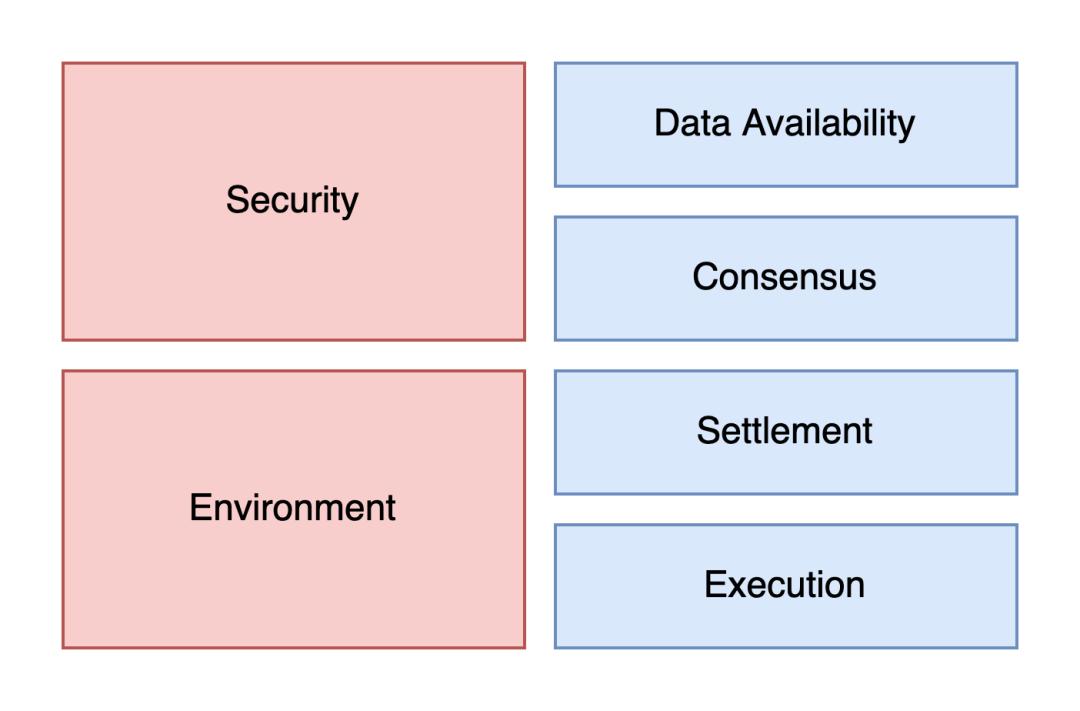
Security Layer: Ensures the security of the blockchain.
- Data Availability Module (referred to as DA hereafter): Ensures that transaction data can be used (ensures storage and verifiability).
- Consensus Module: Determines the order of transactions, etc. (PoW, etc., are mechanisms to prevent attacks and are the foundation of consensus but do not represent all of it).
Execution Environment Layer: Provides the execution environment for the blockchain.
- Settlement Module: Settles state commitments.
- Execution Module: Computes individual state transitions.
For each level, using the same solution for both modules provides higher security and fewer trust assumptions, such as when both settlement and execution use Ethereum's security > only settlement uses Ethereum's security while execution uses Arbitrum's environment security.
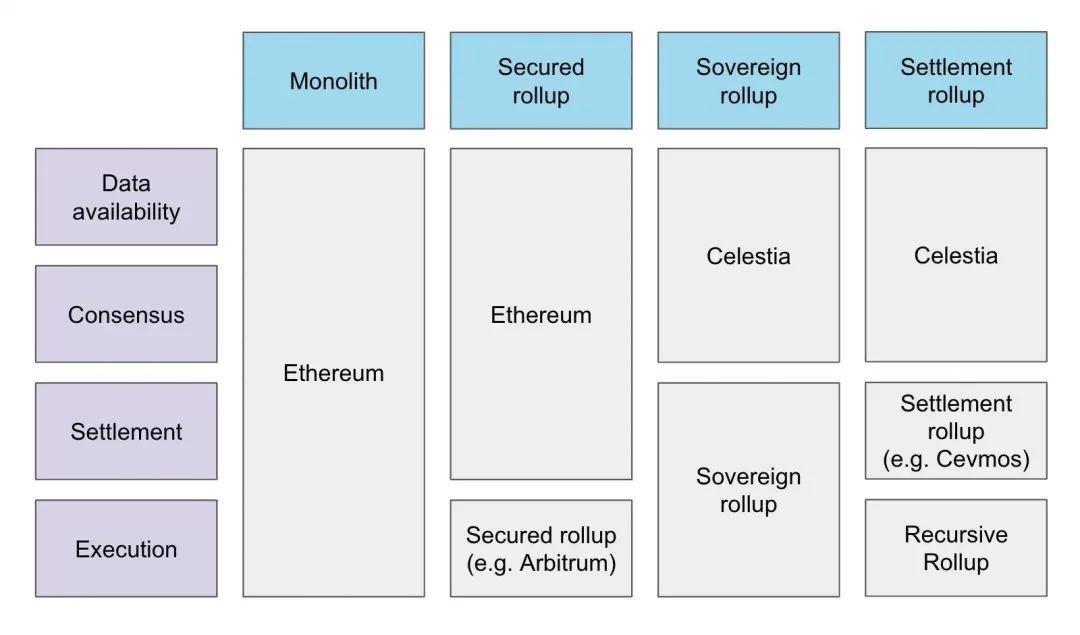
Representatives of monolithic blockchains include Ethereum itself, Solana, Binance Smart Chain, etc., while representatives of Secured Rollup include Arbitrum, Optimism, etc., and representatives of the DA layer include Celestia's DA, Polygon Avail, etc.
If we draw an analogy between blockchain modules and computer architecture, then:
- Blockchain's Execution Module ⇒ Computer's Operating System (the environment that actually executes instructions)
- Blockchain's DA Module ⇒ Computer's Memory (for short-term data access)
- Blockchain's Settlement and Consensus Modules ⇒ Computer's CPU (hardware that ensures the correctness of instruction execution)
In subsequent articles, we will refer to these "modules" as "layers," but they are essentially modules.
b) Predicting Modularization Trends from Web Development
We can draw lessons from the development of the Web to predict the future modularization of blockchain:

The blockchain network is essentially a more decentralized and stable cluster, allowing nodes to pool computational power, forming a large trusted computer spread across the globe.
The modular division of blockchain is very similar to distributed systems in Web2 (not to be confused with distributed databases). It essentially splits business functions, similar to the architecture of Uber in the diagram below, with each module performing its own role.

The distributed systems of Web2 and the modularization of Web3 blockchain raise two questions for us to consider:
- Splitting: The blockchain network has been simply split into the two levels and four modules mentioned earlier.
- Connecting: Ensuring communication and security between modules. This is why modules of the same origin have higher security, as they do not require additional connections, avoiding dangers exposed in the process.
The issue of splitting has been clearly defined, but the issue of connection affects the modular architecture. How to enhance security and user experience may be a problem that modular blockchains need to solve.
c) Why Modularization?
Modular blockchain decouples monolithic blockchains, resulting in a new network structure = multiple different Rollups like Arbitrum and StarkEx + a base layer similar to Ethereum.
The focus of their enhancement is mainly that there is no longer a need to verify and ensure DA through Proof of Replication caused by the coupling of consensus and DA in traditional monolithic blockchains (which limits performance and greatly increases the size of full nodes, affecting decentralization).
This means that modular blockchain networks no longer need to rely on the consensus of monolithic blockchains but instead decouple and directly use specialized layers to handle DA, reducing unnecessary computational power and storage waste under the priority of mainnet security, improving throughput, and bypassing consensus bottlenecks, thus further enhancing TPS to thousands or tens of thousands.
In addition to breaking through performance bottlenecks and entering the next era, what other significant benefits does modular blockchain offer?
Better Blockchain
- Security: The Rollup layer borrows the security of underlying layers like Ethereum.
- Execution Performance: Can flexibly adopt faster execution and/or settlement modules.
Development Composability
- Iteration: Modules are decoupled. Modules can propose more radical changes and innovate more quickly.
- Pluggable: More options for chain development solutions and technology stacks.
d) Different Implementations of Modularization?

Modular blockchain networks can actually create many types of "chains," mainly divided into three major categories and countless subcategories:
- Rollup (including Sovereign or Secured Rollup, see previous article. For example, Ethereum/Celestia security layer + execution environment/or only execution module.)
- Multi-Monolithic (e.g., Tendermint/Substrate security layer + Cevmos stack and Recursive Rollup execution environment. Celestia itself actually belongs to this architecture, as part of the Cosmos ecosystem.)
- Subnet (the most freely assembled modular blockchain, which does not inherit security and focuses more on deployment and development efficiency.)

These three modular blockchains differ significantly from monolithic blockchains, each with its own characteristics:
- Rollup: Speed is the key to success, but the technological progress is the slowest and least mature.
- Multi-Monolithic: Shares security, allows composable and interoperable communication, and application chains have sovereignty, but performance may not be guaranteed.
- Subnet: Rapid deployment, mature solutions, but security and decentralization may not be guaranteed.
- Monolithic: "Complete" freedom, but the solutions are too heavy, and the entire system may be overly coupled.
e) Impact of the Modularization Concept?
With the arrival of the modular blockchain era, the traditional concepts of L1 and L2 may need to be redefined.
- Monolithic Blockchain: L1 refers to monolithic blockchains like Ethereum, while L2 refers to Rollups composed of Ethereum's security layer and execution modules.
- Modular Blockchain: L0 refers to social consensus and trust assumptions about L1, L1 refers to the security layer of modular blockchains (DA and Consensus), and L2 refers to the execution environment layer of modular blockchains (Settlement and Execution).
In addition:
- Performance Measurement: Shifting from consensus's TPS and TTF to comparing DA's throughput.
- Definition: It is important to note that for Rollups like Arbitrum, the Arbitrum network = Arbitrum's execution environment + Ethereum's security layer and settlement module. For Ethereum itself, the Ethereum network = Ethereum's execution environment + Ethereum's security layer and settlement module. When solutions can be modularly decomposed, they can all be referred to as practices of modular blockchain. Networks like Ethereum that are suitable for being L1 can be called modular blockchain networks.
- Trend: When applications want more features, reduce operational costs, or enhance security and greater sovereignty, they can choose suitable solutions from a basket of modules, thus developing App-chains, App-rollups, or App-subnets.
In the future, perhaps every application will choose to become a modular blockchain.
DA Layer
Since Rollup not only ensures security but also enhances performance, why not make blockchain the best soil for Rollup? Modular blockchain allows blockchain to become a better foundational layer for Rollup.
Rollup has drawn attention to the impact of the DA layer on performance, and at the same time, the emergence of Rollup has inspired the concept of modular blockchain networks focused on multiple Rollup ecosystems. Modular blockchain allows blockchain to transcend the consensus bottlenecks of the monolithic era and enter an era of modular concepts focused on DA.
"Rollup is to move the execution layer off-chain, and the next step is to move DA off-chain."
a) What is DA?
For modular blockchains and Rollup networks, complete data needs to be there and guaranteed to be usable to ensure the decentralization and security of the network:
Current Data Availability: Why is it necessary to have the latest state root and tx data available when producing blocks?
Because to produce a new block, all this data needs to be exposed on L1 so that other nodes can re-execute it for verification, and this process must ensure the security of light clients (which only check the block headers! They do not reject invalid transactions).
Archive Data Availability: After a block is valid, does tx data still need to be retained to ensure availability?
Yes. For example, you may want to check a transaction from months ago, or you may want to run a node from scratch.
Rollup and Modular Blockchain: What does Current Data Availability mean for Rollup and future different modular blockchain practices?
Optimistic Rollup: When producing new blocks, state root data needs to be available for verification; during the challenge period, tx data needs to be available to make challenging the Sequencer feasible, ensuring security.
zk Rollup: In the case of the Sequencer running away, state root data is needed to reconstruct the state and withdraw funds.
b) Current Data Availability
The availability of the latest data affects the security and performance of the network itself.

When we talk about DA, we usually refer to this.
Monolithic Blockchain Era:
- DA Solution: Since consensus and DA are not decoupled, it relies on full nodes Proof of Replication.
- Data is there: Guaranteed by a bunch of full nodes replicating complete data.
- Data Available: Verified by downloading complete data with linear complexity.
- tx Validity: Verified by re-execution.
- Problem: Excessive redundancy, and if nodes only store part of the data on average, the probability of data loss is very high (similar to the birthday paradox).
Modular Blockchain Era:
- DA Solution: Dedicated independent DA solutions.
- Data is there: Guaranteed by erasure coding (the data protection scheme used by CD and satellites).
- Data Available: Verified through data availability sampling in sublinear time, such as only needing to download 1% of block data to obtain a 99% guarantee of block availability.
- tx Validity: Ensured through error coding proofs (similar to the Optimistic mechanism) or polynomial commitments, or even directly through validity proofs (commonly referred to as zk proofs) to ensure the correctness of erasure coding, making tx valid.
c) Archived Data Availability
The availability of archived data only affects infrastructure outside the network, such as blockchain explorers, and may be optional for the network itself, but must be available for user use.
First, we need to clarify that the Web3 storage solutions of Arweave or Filecoin cannot provide direct DA for Current Data Availability:
- Arweave: SPoRA. Essentially a probabilistic storage under the assumption of Moore's Law and economic models (of course, everything is probabilistic…). In practice, it usually takes waiting for more than ten blocks to confirm that data is "permanently stored," which cannot guarantee immediate DA well.
- Filecoin: PoSt. A peer-to-peer distributed storage network. Miners storing data can withhold data, which cannot guarantee decentralization and DA.
- IPFS: Primarily exists as infrastructure, used in the DA network layers of Polygon Avail and Celestia.
In addition, Arweave and Filecoin still rely on the multi-replica redundancy model of monolithic blockchains to ensure data availability, making it difficult to establish efficient sampling mechanisms.
While they are not suitable as "memory" to provide availability for the latest data, they are suitable as "hard drives" to provide availability for archived data. Currently, Web3 still lacks a more modular and focused dedicated "hard drive."
Choices for Modular Blockchain
Now, as architects of a project with tens of thousands of TPS, let's make some choices for our application and combine suitable application chains.

a) DA Layer Ecosystem
The DA layer is a direction that has recently garnered a lot of attention. However, from our decision diagram, there is actually not a high probability of continuously making "correct" prior choices, ultimately leading to DA choices.
Apart from the most likely project to adopt self-built private DAC (performance + sovereignty) or sidechain DA solutions, there are basically three main thought processes for DA solutions:
- Highest Security: Consistent with the consensus layer, such as DA and consensus both using Ethereum or Celestia.
- Extreme Throughput: Sacrificing security, increasing additional trust assumptions, such as off-chain data committees (security is similar to multi-signature, but weaker).
- Both: Achieving high security and high throughput through a Restaking model, such as DataLayr.
The commercial landscape for DA solutions will likely look like this:
- Business Model: Aimed at application chains, charging a "protection fee" for DA provided to application chains.
- Competition: The strength of DA solutions is essentially a comparison of two levels: security and throughput. The one with better throughput can easily achieve overwhelming victory.
- Value Capture: Since there are not many instances in practice to analyze and compare, we can consider the following questions: If the market value of the DA layer is far lower than that of the application chain (like the relationship between Chainlink and DeFi applications), does the entire protocol thus have a security shortcoming? Can the DA layer alone form a complete application ecosystem, and how can tokens capture value?
b) Execution Layer Ecosystem
If we compare modular blockchain to a highly specialized kitchen, the performance of the blockchain is the speed of serving dishes, while the larger throughput DA layer is like a bigger pot, and a better execution environment is like a more skilled chef who can cook more cuisines.
The execution layer solutions also have several choices:
- Existing mature solutions: EVM and its ZK or OP variants, WASM and its various variants, etc.
- Future cutting-edge solutions: FuelVM (the workflow is shown in the lower part of the diagram, thus faster), AltLayer, etc.
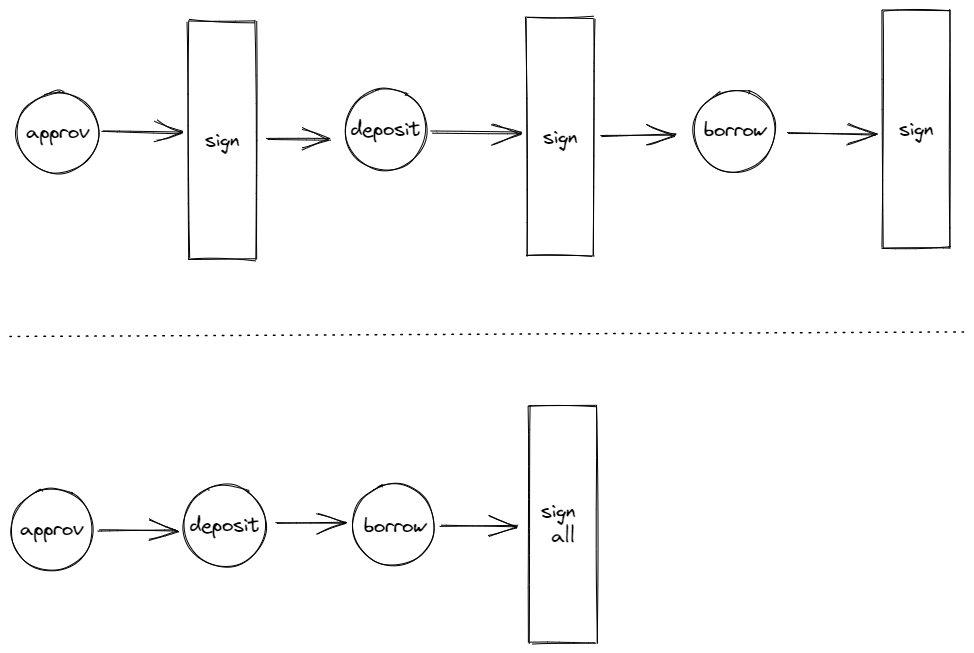
For the execution layer, I believe EVM will still maintain its leading position in the future due to its excellent ecosystem.
For value capture of cutting-edge execution layer solutions, they can easily be combined into Optimistic Rollup, forming an application ecosystem, thus having a natural advantage over the DA layer in terms of value capture.
c) Consensus Layer Ecosystem
For modular blockchain, the consensus layer needs to:
- Prioritize security: Ensure the stability and security of the underlying layer.
- Smart contract environment: Facilitate on-chain verification of various outputs.
- Social and economic consensus: Needs to be a "well-respected" public chain, so that no additional trust assumptions are required.
Thus, we have few suitable choices left:
- Fully suitable: Ethereum, Cosmos, etc.
- Marginally suitable: Bitcoin, Arweave (both lack Turing-complete smart contracts on-chain, with settlement occurring on application chains), etc.
- Not very suitable: Solana (the network is not particularly stable), etc.
- Possibly most suitable: Future Celestia, future Ethereum.
Thoughts on Modular Solutions
a) Further Exploration
DA Layer: The state explosion problem raises the entry barrier for the network too high, weakening the decentralization of the network. The statelessness we discussed in the DA section is merely weak statelessness, meaning only the block producer needs to store state data; further optimizations are needed to ensure that all nodes do not need to store all state data.
Execution Layer: The current modular division merely opens many execution layers (Sharding), and when a certain execution layer is fully loaded, its performance still cannot meet Web3 demands. Therefore, what we need to expand is more the performance of individual execution layers (Parallelization), such as Fuel and Solana.
b) Demand and Supply
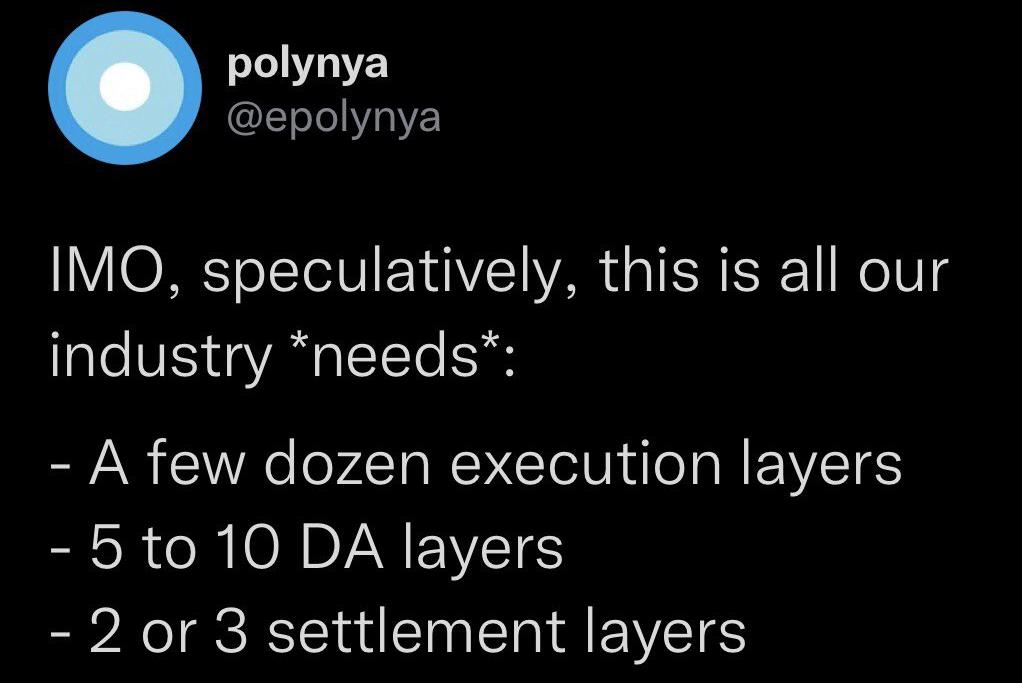
How much demand is there for App-chains?
Currently, only popular applications have a demand for App-chains. We may need to onboard more users to stimulate the true mass demand for modular solutions.
At the same time, we also see countless module choices, and ultimately which ones can truly be actively used is also a process that needs exploration and filtering.
c) Security
Modularization has two aspects: splitting and connecting:
- Does splitting lead to the entire blockchain network having shortcomings? Reducing the funds required to attack its shortcomings significantly, potentially triggering tragedies like Luna as a lead role similar to Curve pools?
- The more complex a system is, the more exposed attack surfaces it has. Is there a possibility of being attacked in the "connection" between modules (of course, Rollup bridges are actually safer than IBC bridges)? (In previous articles, we expressed views on the dangers of composability)

d) Experience

A decentralized modular system may lead to a split in user experience and funds simply due to different execution layers, and will it also cause a split in developer experience due to different development tools? How is MEV handled?
e) Separation Leads to Unity
Similar to Apple's transition from Intel chips to M-series SoCs, will the relatively fragmented architecture of modular blockchain unify in a few years due to ecological or experiential issues, and will monolithic blockchains regain dominance? Will modular blockchains see the emergence of interoperability protocols similar to Cosmos IBC?
Conclusion
Currently, modular blockchain has only scratched the surface, but it is already very prosperous, with various Secured Rollups based on Ethereum, Cosmos, Polkadot, Subnet, etc.
Bitcoin is the concept of blockchain, Ethereum is the practice of blockchain, and modular blockchain will be the foundation for blockchain to be widely engineered and practiced.




